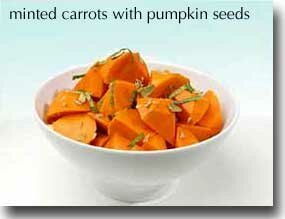If you don't know what to serve for breakfast today ...
This is a delightfully easy and refreshing way to serve carrots that complements many dishes. The pumpkin seeds add extra nutrition and great texture.

Ingredients:
- 6 medium-sized carrots peeled and cut in turned pieces
- 1/2 TBS fresh chopped parsley
- 1 TBS fresh chopped mint
- 1 TBS coarsely chopped pumpkin seeds
- 2 TBS lemon juice
- extra virgin olive oil to taste
- salt and cracked black pepper to taste
- Bring lightly salted water to a boil in steamer with a tight fitting lid.
- Steam carrots in basket until al denté (slightly crunchy inside).
- Chop rest of ingredients and toss with carrots when done.
In-Depth Nutritional Profile for Minted Carrots with Pumpkin Seeds
Healthy Food Tip
Does the iodine value of kelp depend on the location it was grown?
Yes, the amount of iodine contained in kelp and all other sea vegetables depends heavily on its environment. While all plants—both sea plants and land plants—depend on their environment for mineralization, the circumstances are particularly variable with respect to sea plants and iodine.
Let me give you one example from a research study that examined the iodine content of sea vegetables from a variety of different locations, including waters off the coasts of the United States, Canada, Tasmania, and Namibia. This study found one species of the sea vegetable nori to contain over 8,165 micrograms of iodine per gram of plant!
To give you a better idea of how much iodine this amount represents, consider the fact that one tablespoon's worth of fresh sea vegetable will weigh approximately 5 grams, which would give one tablespoon of this particular nori over 40,000 micrograms of iodine. Since the Dietary Reference Intake (DRI) level for iodine for daily recommended iodine is 150 micrograms, this amount would represent about 266 times the recommended amount! It would also be about 40 times more than the recommended limit for daily iodine intake. This level, called the Tolerable Upper Limit (UL), is set for 1,100 micrograms for adults. On the other hand, in this same research study, scientists found some samples of kelp to contain only 16 micrograms of iodine per gram, leaving a tablespoon to contain approximately 80 micrograms and under 55% of the recommended daily intake level.
Even though two different types of sea vegetables (nori and kelp) are being compared in the above example, dramatic differences of this kind of iodine content can occur within the kelp family or within the nori family. In other words, not only is it impossible to find a constant iodine level among the different types of sea vegetables, but it is also impossible to find a constant iodine level within kelp sea vegetables, or nori sea vegetables, or within other types of these ocean foods.
Researchers have tried to determine the reason for these amazing differences in sea plants and their iodine content, and there appear to be many different factors. Most of these factors are related to the changing needs of the plants, including the operation of their chemical defense systems and their antioxidant needs.
Unfortunately, for us humans who may need to focus on our level of iodine intake, this situation makes sea vegetables a non-dependable source of iodine, and a potentially risky source of excess iodine.
For these reasons, I do not recommend that you count on sea vegetables as a dependable food for offsetting an iodine deficiency, and I also recommend that you think about sea vegetables as a potential source of iodine excess. (Many food databases do not even report the iodine content of sea vegetables due to this unusual amount of variability in sea vegetables when it comes to this mineral). Some manufacturers of sea vegetables do measure the iodine content in their products and present this information on their labeling. This type of information can of course be extremely helpful.
The World's Healthiest Foods can offer a range of other foods that are valuable sources of iodine. For more information about iodine-containing foods, visit the Essential Nutrients section of our website (http://whfoods.org/nutrientstoc.php) and click on the "Iodine" link.
References
Lu L, Qian Y, Lu X. . Wei Sheng Yan Jiu 2004 Sep;33(5):618-9.
Mussig K, Thamer C, Bares R, et al. Iodine-induced thyrotoxicosis after ingestion of kelp-containing tea. J Gen Intern Med 2006 Jun;21(6):C11-4.
Sun XW, Weng HX, Qin YC. Release of bioactive active iodine in kelp. J Environ Sci (China) 2005;17(2):241-4.
For more information on this topic, please see:

No comments:
Post a Comment